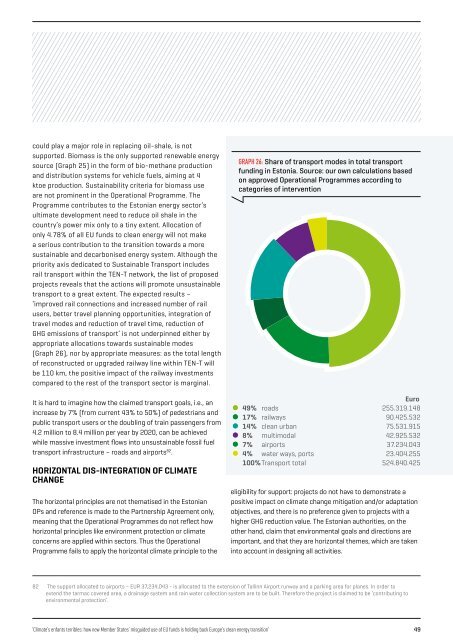ENFANTS TERRIBLES
enfants-terribles
enfants-terribles
You also want an ePaper? Increase the reach of your titles
YUMPU automatically turns print PDFs into web optimized ePapers that Google loves.
could play a major role in replacing oil-shale, is not<br />
supported. Biomass is the only supported renewable energy<br />
source (Graph 25) in the form of bio-methane production<br />
and distribution systems for vehicle fuels, aiming at 4<br />
ktoe production. Sustainability criteria for biomass use<br />
are not prominent in the Operational Programme. The<br />
Programme contributes to the Estonian energy sector’s<br />
ultimate development need to reduce oil shale in the<br />
country’s power mix only to a tiny extent. Allocation of<br />
only 4.78% of all EU funds to clean energy will not make<br />
a serious contribution to the transition towards a more<br />
sustainable and decarbonised energy system. Although the<br />
priority axis dedicated to Sustainable Transport includes<br />
rail transport within the TEN-T network, the list of proposed<br />
projects reveals that the actions will promote unsustainable<br />
transport to a great extent. The expected results –<br />
‘improved rail connections and increased number of rail<br />
users, better travel planning opportunities, integration of<br />
travel modes and reduction of travel time, reduction of<br />
GHG emissions of transport’ is not underpinned either by<br />
appropriate allocations towards sustainable modes<br />
(Graph 26), nor by appropriate measures: as the total length<br />
of reconstructed or upgraded railway line within TEN-T will<br />
be 110 km, the positive impact of the railway investments<br />
compared to the rest of the transport sector is marginal.<br />
It is hard to imagine how the claimed transport goals, i.e., an<br />
increase by 7% (from current 43% to 50%) of pedestrians and<br />
public transport users or the doubling of train passengers from<br />
4.2 million to 8.4 million per year by 2020, can be achieved<br />
while massive investment flows into unsustainable fossil fuel<br />
transport infrastructure – roads and airports 82 .<br />
HORIZONTAL DIS-INTEGRATION OF CLIMATE<br />
CHANGE<br />
The horizontal principles are not thematised in the Estonian<br />
OPs and reference is made to the Partnership Agreement only,<br />
meaning that the Operational Programmes do not reflect how<br />
horizontal principles like environment protection or climate<br />
concerns are applied within sectors. Thus the Operational<br />
Programme fails to apply the horizontal climate principle to the<br />
GRAPH 26: Share of transport modes in total transport<br />
funding in Estonia. Source: our own calculations based<br />
on approved Operational Programmes according to<br />
categories of intervention<br />
Euro<br />
49% roads 255.319.148<br />
17% railways 90.425.532<br />
14% clean urban 75.531.915<br />
8% multimodal 42.925.532<br />
7% airports 37.234.043<br />
4% water ways, ports 23.404.255<br />
100% Transport total 524.840.425<br />
eligibility for support: projects do not have to demonstrate a<br />
positive impact on climate change mitigation and/or adaptation<br />
objectives, and there is no preference given to projects with a<br />
higher GHG reduction value. The Estonian authorities, on the<br />
other hand, claim that environmental goals and directions are<br />
important, and that they are horizontal themes, which are taken<br />
into account in designing all activities.<br />
82<br />
The support allocated to airports – EUR 37,234,043 - is allocated to the extension of Tallinn Airport runway and a parking area for planes. In order to<br />
extend the tarmac covered area, a drainage system and rain water collection system are to be built. Therefore the project is claimed to be ‘contributing to<br />
environmental protection’.<br />
‘Climate’s enfants terribles: how new Member States’ misguided use of EU funds is holding back Europe’s clean energy transition’ 49


